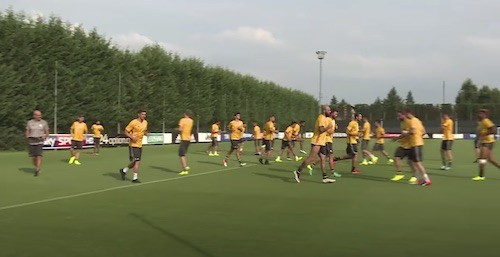Soccer training tips for practicing on our own or with your team: Below are some useful soccer training tips for players who want to play at the highest level, from how to communicate on the soccer field to how to shield the ball to how to surprise the opposing team with a blind pass. The blind pass is a cross field switch, where your body is facing the opposite direction of where you play the ball. This opposite field pass isn’t used enough in the game. Master the fundamentals of the game of soccer and then take your game to the next level with these soccer training tips.
Image credit goes to Juventus for top picture.
If you want to become a better soccer player follow these soccer tips below. And it doesn’t matter if you’re a beginner or an advanced player, these useful soccer tips apply to players of all levels. This is also soccer advice for both players and coaches.
These soccer tips below will raise your game to another level, but it will take practice and dedication to become a professional soccer player. There’s no short cut to improving as a player except spending time with the ball on your own and playing with players who are better than you are.
Communicate in Soccer
When you move into the professional soccer level it becomes even more important to communicate on the field. Simple directions or alerts, such as ‘man on’ and ‘turn’ or ‘you have time’, make playing the game so much easier and become more important as the game speeds up.
Communication is also about asking for the ball all the time. Yes, you’ll need to ask for the ball – tell your teammates you want it. Demand the ball even. And it really doesn’t matter what position you play, whether you’re a right back or a forward, you should always want the soccer ball. The idea is you want to help and offer support and make things happen. Otherwise, why are you out there playing.
At the same time though, once you get the ball, give it to the player who is in the best position to create something. Give it to the player who can do the most damage to the other team with the ball. Often on a team there are two or three players, or maybe one, who you always want to have the ball at their feet. These are the play makers, when they are open, pass them them ball and then make a run to get the ball back. Watch the best teams in the world, there’s always two or three players who always get the ball at their feet and run the show.
Players like Messi and Xavi at Barcelona. Both are play makers and combine cleverly with Dani Alves on the right side. Alves acts as support player, like a wall that Messi and Xavi can play off of and get the ball back when they are open again. Alves of course is a unique player, as he’s extremely skilled, and can get down the line to cross the ball and into the attack. But players should work together and share the ball, and Messi, Xavi, and Alves offer no better example of this.
Communicate through how you play the ball itself, if you play a hard ball into someone’s feet that tells the player they are under pressure. If you play a soft pass to someone that means you’re trying to draw the player back to the ball to open up space behind them. Overall, play crisp passes to your teammates, if not, the ball will get cut out by the defense and it’s easy to control a firm pass. This is one of those soccer tips that all players should learn at a young age.
Play the Soccer Ball Quickly
The key though is to give the ball and get the ball – play the ball quickly in one and two touches. If you hold on to the ball too long you will lose it. And even if you don’t lose the ball, if you don’t play the ball quickly, you can kill an attack and allow the opposing team to get back on defense.
Also, this means you should be prepared to receive the soccer ball at all times, and of course want the ball! This kind of energy, wanting to always be involved in the play, puts the other team that much more on their heels. So play simple and smart soccer, give and get the ball and move it quickly.
Try to attack the space when you have the ball. See if you can draw a defender in, and then release the ball just when they’re about to close you down or win the ball. There’s a certain flow to the game of soccer when things are going well. Everyone is on the same page, fighting for one another and sharing the ball. That’s the type of soccer you want to play. This often comes from sharing and moving the ball quickly with one and two touches passing.
Shielding the Soccer Ball
A simple and great exercise is to dribble in a small square and have an opponent try to take the ball from you. Use your body to shield the ball from the defender. Always keep your body between the ball and the defender. Tell your friend or the person who is acting as the defender to fight for the ball with a game like intensity, pushing you and playing so hard they are almost fouling you. Add more players into the game as you get more confident holding on to the ball and holding off the defender. If the defender wins the ball you switch roles.
This game can eventually build into a possession game that focuses on shielding. Call out to stop play now and again and whichever team doesn’t have the ball has to do push-ups or a few sprints as punishment.
When shielding the ball, and there’s space, carry the ball into the open space – all the while shielding the ball from the defender. Carry the ball with the inside of your foot, this is where you will get the most control, kind of dragging the ball along as the defender pushes against you. Make sure to bend your knees and have a strong sense about you that this person is not going to get the ball from you no matter what. Then, try to work on cutting the ball back and forth. Carry the ball with the inside of your foot for a few yards and then cut back with the outside of your foot and shield the ball with the outside of your foot. As you get better, practice shielding the ball using all parts of both feet.
Shielding the soccer ball, protecting it with your body, is one of the most underrated skills in soccer. As you get more comfortable, try shielding the ball for a few yards with the inside of your right foot and playing it to your left and carrying it in the other direction. Next, use the sole of your foot to turn or switch directions. Try to use all the different surfaces of your foot without letting the defender get a touch on the ball. Chop and cut the ball back with the inside and outside of both feet. Keep the defense honest by turning and taking the defender on from time to time. This way they know you’re actually trying to get past them and not just hold the ball.
Also see Iniesta’s shielding skills. For a skinny and small soccer player he knows how to protect the ball.
Play with Older Soccer Players
If you want to get better, try to find the best game possible near where you live when you are training. To become a great player you should push yourself, and there is no better way to do this than to play with more experienced players who are better than you are.
The idea is to pick up all of their tricks and skills that they have learned over the years. This kind of mentoring process is a huge part of improving your game and you often won’t even realize what subtle skills you’ll pick up, just by watching and playing with better and more experienced players.
Challenging yourself by playing with experienced players will speed up your play, make you play stronger on the ball, and you’ll learn from their experience – where to play the ball, when to pass, when to dribble, and where to make runs.
And it’s not just about playing with experienced or older players, it’s about playing with players who are better than you are. If there’s one short cut to getting better it’s playing with players who are better than you are.
Quick Decisions in Soccer
While you want to slow down when you’re in the box and about to shoot on goal, during the course of the game you’ll have to make quick decisions. As a professional soccer player, you won’t have time to really think when receiving the soccer ball. Know what you are going to do with the ball before you get it. This means knowing where your support is coming from and receiving the ball with your body blocking it from the defender. Barcelona are experts at this, every pass is made to the right side of the player and they always have support around each other, usually in triangles, with support in front to the side and in back. But Barcelona play the ball quickly, something that is probably hard to ascertain when just watching on television.
Eventually, playing simple soccer will become automatic when you are involved in the rhythm of the game. But it’s important to want and ask for the ball. If you don’t ask for the ball you might not get it – they might think you don’t want it or aren’t open.
Again, use your body to shield the ball so a defender can’t win the ball or if they do you’ll earn a throw in or a free kick. To get out of pressure, play simple give and goes with your teammates. Be aware of where you can move or how you can position yourself to help out your teammates.
Using your body means dribbling with your left foot when there is a defender on your right and dribbling and shielding the ball with your right foot when there is a defender on your on your left. If you don’t know if you can turn or have time, keep your body between the ball and the defender and keep your head so you can find a teammate. You should always try to know where you are on the field by taking quick looks before you receive the ball. The key though is not to panic, if you’re closed down, shield the ball and protect it.
The idea behind soccer is really simple, it’s kind of like this, “Hey, hold the ball for a second while I get open or in a better position where I will have more time and can see the field better.” If you watch the best teams in the world, whether it’s Barcelona, Arsenal or Real Madrid, they move the ball around to the player with the most time and space. It’s a big game of keep away in a sense. And this is one of the greatest aspects of the game of soccer, where you work with your teammates to ping the ball around the other team, and they can’t even get a touch on the ball before you score a goal.
More Soccer Training Tips:















